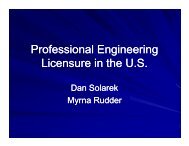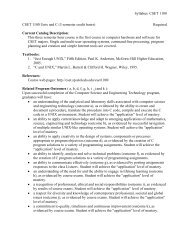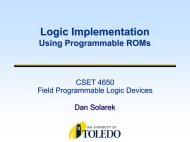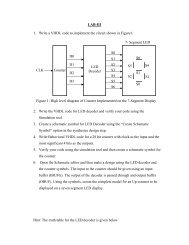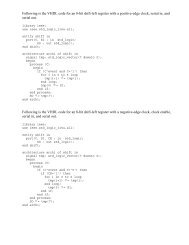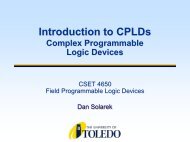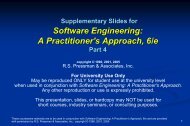Programmable Logic and Application Specific Integrated Circuits
Programmable Logic and Application Specific Integrated Circuits
Programmable Logic and Application Specific Integrated Circuits
You also want an ePaper? Increase the reach of your titles
YUMPU automatically turns print PDFs into web optimized ePapers that Google loves.
ASIC<br />
<strong>Application</strong> <strong>Specific</strong><br />
<strong>Integrated</strong> Circuit<br />
ASSP<br />
<strong>Application</strong> <strong>Specific</strong> St<strong>and</strong>ard Part<br />
St<strong>and</strong>ard (Commodity) Part<br />
Figure 1. VLSI Market Hierarchy<br />
An even more gray area is created by the previously discussed ASSPs. Although they are<br />
built using traditional ASIC technology, they are sold like st<strong>and</strong>ard parts. Nonetheless, the term<br />
ASIC is still quite useful. In addition to describing gate array, st<strong>and</strong>ard cell, <strong>and</strong> PLD chip<br />
designs, ASIC describes a methodology (or group of methodologies) for designing electronic<br />
systems, <strong>and</strong> it describes a technology (or group of technologies) used to build electronic systems.<br />
Most of today’s flexible <strong>and</strong> cost effective electronic systems are designed using ASIC<br />
methodologies <strong>and</strong> built using ASIC technology.<br />
It is clear that a wide range of <strong>Integrated</strong> Circuit (IC) design options are available for<br />
electronic system construction. Many factors must be considered in order to make informed<br />
choices about the chips that we purchase, specify, or design. The remainder of this introduction<br />
provides a broad comparison of the ASIC <strong>and</strong> programmable logic technologies, <strong>and</strong> identifies<br />
both technical <strong>and</strong> economic selection criteria. Section II provides an overview of the<br />
semiconductor processing technologies in use today, <strong>and</strong> provides a brief comparison of<br />
technology attributes. In Section III an in-depth evaluation of field-programmable logic devices is<br />
presented together with examples of currently available commercial chips. Sections IV <strong>and</strong> V<br />
present information about the more traditional gate array <strong>and</strong> st<strong>and</strong>ard cell ASIC design<br />
methodologies. Finally, Sections VI <strong>and</strong> VII discuss system implementation <strong>and</strong> application issues<br />
including ASIC packaging, behavioral modeling, design for testability, <strong>and</strong> mixed-signal design..<br />
A. Overview of ASIC Design Options<br />
This section introduces the range of options <strong>and</strong> styles available for integrated circuit<br />
design. Although the bulk of this chapter will focus on the programmable logic design style, this<br />
section places programmable logic in context alongside the alternate design techniques. The<br />
following sections are loosely organized in order of decreasing design investment (non-recurring<br />
engineering costs) <strong>and</strong> corresponding maximum chip complexity.<br />
4




